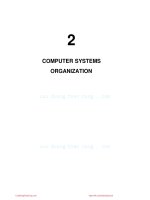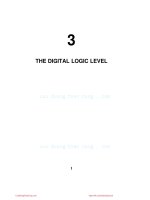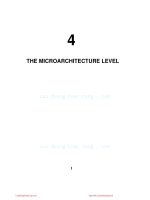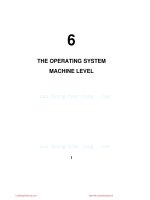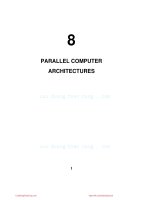kiến trúc máy tính dạng thanh tin figs 1 introduction sinhvienzone com
Bạn đang xem bản rút gọn của tài liệu. Xem và tải ngay bản đầy đủ của tài liệu tại đây (31.53 KB, 12 trang )
1
INTRODUCTION
1
CuuDuongThanCong.com
/>
Virtual machine Mn, with
machine language Ln
Level 3
Virtual machine M3, with
machine language L3
…
Level n
Level 2
Level 1
Level 0
Programs in Ln are
either interpreted by
interpreter running
on a lower machine, or
are translated to the
machine language of a
lower machine
Virtual machine M2, with
machine language L2
Programs in L2 are
either interpreted by
interpreters running
on M1 or M0, or are
translated to L1 or L0
Virtual machine M1, with
machine language L1
Programs in L1 are
either interpreted by
an interpreter running on
M0, or are translated to L0
Actual computer M0, with
machine language L0
Programs in L0 can be
directly executed by
the electronic circuits
Figure 1-1. A multilevel machine.
CuuDuongThanCong.com
/>
Level 5
Problem-oriented language level
Translation (compiler)
Level 4
Assembly language level
Translation (assembler)
Level 3
Operating system machine level
Partial interpretation (operating system)
Level 2
Instruction set architecture level
Interpretation (microprogram) or direct execution
Level 1
Microarchitecture level
Hardware
Level 0
Digital logic level
Figure 1-2. A six-level computer. The support method for
each level is supported is indicated below it (along with the
name of the supporting program).
CuuDuongThanCong.com
/>
*JOB, 5494, BARBARA
*XEQ
*FORTRAN
FORTRAN
program
*DATA
Data
cards
*END
Figure 1-3. A sample job for the FMS operating system.
CuuDuongThanCong.com
/>
Year
1834
1936
1943
1944
1946
1949
1951
1952
1960
1961
1962
1963
1964
1964
1965
1970
1974
1974
1978
1981
1985
1987
1990
Name
Analytical Engine
Z1
COLOSSUS
Mark I
ENIAC I
EDSAC
Whirlwind I
IAS
PDP-1
1401
7094
B5000
360
6600
PDP-8
PDP-11
8080
CRAY-1
VAX
IBM PC
MIPS
SPARC
RS6000
Made by
Babbage
Zuse
British gov’t
Aiken
Eckert/Mauchley
Wilkes
M.I.T.
Von Neumann
DEC
IBM
IBM
Burroughs
IBM
CDC
DEC
DEC
Intel
Cray
DEC
IBM
MIPS
Sun
IBM
Comments
First attempt to build a digital computer
First working relay calculating machine
First electronic computer
First American general-purpose computer
Modern computer history starts here
First stored-program computer
First real-time computer
Most current machines use this design
First minicomputer (50 sold)
Enormously popular small business machine
Dominated scientific computing in the early 1960s
First machine designed for a high-level language
First product line designed as a family
First scientific supercomputer
First mass-market minicomputer (50,000 sold)
Dominated minicomputers in the 1970s
First general-purpose 8-bit computer on a chip
First vector supercomputer
First 32-bit superminicomputer
Started the modern personal computer era
First commercial RISC machine
First SPARC-based RISC workstation
First superscalar machine
Figure 1-4. Some milestones in the development of the modern digital computer.
CuuDuongThanCong.com
/>
Memory
Control
unit
Input
Arithmetic
logic unit
Output
Accumulator
Figure 1-5. The original von Neumann machine.
CuuDuongThanCong.com
/>
CPU
Memory
Console
terminal
Paper
tape I/O
Other
I/O
Omnibus
Figure 1-6. The PDP-8 omnibus.
CuuDuongThanCong.com
/>
Property
Relative performance
Cycle time (nsec)
Maximum memory (KB)
Bytes fetched per cycle
Maximum number of data channels
Model 30
1
1000
64
1
3
Model 40
3.5
625
256
2
3
Model 50
10
500
256
4
4
Figure 1-7. The initial offering of the IBM 360 product line.
CuuDuongThanCong.com
/>
Model 65
21
250
512
16
6
100000000
16M
64M
10000000
1M
Transistors
1000000
100000
256K
4K
10000
1000
4M
64K
16K
1K
100
10
1
1965
1970
1975
1980
1985
1990
1995
Figure 1-8. Moore’s law predicts a 60 percent annual increase
in the number of transistors that can be put on a chip. The data
points given in this figure are memory sizes, in bits.
CuuDuongThanCong.com
/>
Type
Disposable computer
Embedded computer
Game computer
Personal computer
Server
Collection of Workstations
Mainframe
Supercomputer
Price ($)
1
10
100
1K
10K
100K
1M
10M
Example application
Greeting cards
Watches, cars, appliances
Home video games
Desktop or portable computer
Network server
Departmental minisupercomputer
Batch data processing in a bank
Long range weather prediction
Figure 1-9. The current spectrum of computers available. The
prices should be taken with a grain (or better yet, a metric ton)
of salt.
CuuDuongThanCong.com
/>
Chip
4004
8008
8080
8086
8088
80286
80386
80486
Pentium
Pentium Pro
Pentium II
Date
MHz Transistors Memory
Notes
4/1971
0.108
2,300
640 First microprocessor on a chip
4/1972
0.108
3,500
16 KB First 8-bit microprocessor
4/1974
2
6,000
64 KB First general-purpose CPU on a chip
6/1978
5-10
29,000
1 MB First 16-bit CPU on a chip
6/1979
5-8
29,000
1 MB Used in IBM PC
2/1982
8-12
134,000
16 MB Memory protection present
10/1985
16-33
275,000
4 GB First 32-bit CPU
4/1989 25-100
1.2M
4 GB Built-in 8K cache memory
3/1993 60-233
3.1M
4 GB Two pipelines; later models had MMX
3/1995 150-200
5.5M
4 GB Two levels of cache built in
5/1997 233-400
7.5M
4 GB Pentium Pro plus MMX
Figure 1-10. The Intel CPU family. Clock speeds are measured in MHz (megahertz) where 1 MHz is 1 million cycles/sec.
CuuDuongThanCong.com
/>
Pentium
II
10M
Pentium
1M
Transistors
80286
100K
Moore's law
8080
4004
1K
8008
10K
80486
Pentium
Pro
80386
8086
8088
100
10
1
1970 1972 1974 1976 1978 1980 1982 1984 1986 1988 1990 1992 1994 1996 1998
Year of introduction
Figure 1-11. Moore’s law for CPU chips.
CuuDuongThanCong.com
/>

